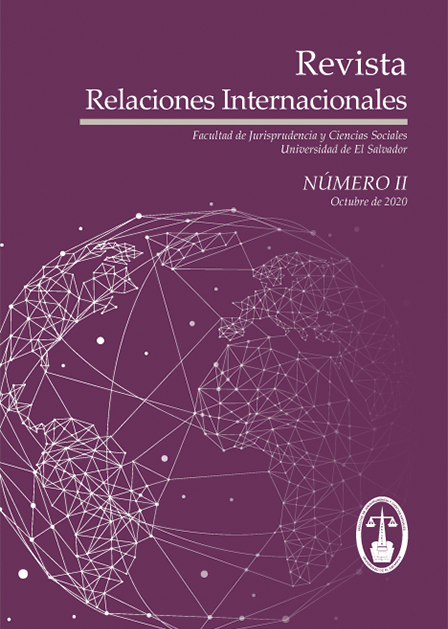China and United States, a binomial of power in the world order, 2010- 2019. Opportunity or threat to Central American security?
Keywords:
China, United States, Central America, Threats, Security, Power, World Order, Geopolitics, International Politics, International RelationsAbstract
The world order, seen from different poles, the military, political and economic, has from the last 10 years three key references in the international community, Russia, China and the States United. These countries, after the cold war and a historical process of reordering economic, have grown considerably in their political influence, such that said expansion has reached the Latin American region; where, although it does not show from Obviously, Central America can be a key geopolitical territory for such outreach, specifically in the interests of China and the United States. Faced with such international influence exerted by the States in question and the internal political and social situation, it has caused the Central American institutionality to be immersed in an unstable situation. This has given way that, in a certain way, the region is involved in commercial, economic or financial mechanisms, which have tied it politically based on international interests, which range from security, natural resources, logistics elements among others. In this sense, beyond perceiving these links as threats, joint diplomatic and institutional mechanisms must be created to be able to cope with this situation in a coordinated manner and thus be able to turn it into an opportunity for development. Central America is going through a key stage to balance its interests and the geopolitical position it can occupy in that dichotomy of power; however, it is necessary to align interests and political identities in order to have a coordinated vision of global geostrategy and the capacities that are possessed and that can be translated into security opportunities in the international system.
Downloads
References
Alex Gray, “The World’s 10 Biggest Economies in 2017,” World Economic Forum, 2017, https://www.weforum.org/agenda/2017/03/worlds-biggest-economies-in-2017/.
Alianza para la Prosperidad del Triángulo Norte. “Lineamientos Del Plan de La Alianza Para La Prosperidad Del Triángulo Norte,” 2014. https://issuu.com/presidenciasv/docs/lineamientos_del_plan_de_la_alianza
Allen Forbes, “China Encabeza Nuevo Orden Mundial,” Opinión, La Nación, 2013.
Bjorn Moller., “The Concept of Security: The Pros and Cons of Expansion and Contraction,” IPRA Secretary General 36, no. 18 (2000): 25.
Christopher Woody and Jenny Cheng, “Here’s the Hardware the World’s Top 25 Militaries Have in Their Arsenals,” Business Insider, 2019, https://www.businessinsider.com/here-are-the-worlds-most-powerful-militaries-2018-2.
Colin S. Gray, Hard Power and Soft Power: The Utility of Military Force as an Instrument of Policy in the 21st Century (Carlisle, PA: Strategic Studies Institute, 2011).
Cristina De Esperanza, “Entre China y Estados Unidos: El Dilema de Australia,” El Orden Mundial, enero 2019, https://elordenmundial.com/entre-china-y-estados-unidos-el-dilema-de-australia/.
Dilip Hiro, After Empire, the Birth of a Multipolar World (New York: Nation Books, 2010), 180.
Erich de la Fuente, La Política Exterior de Los Estados Unidos Hacia América Latina En La Era Trump, (Madrid: Llorente & Cuenca, 2017). https://ideas.llorenteycuenca.com/wp-content/uploads/sites/5/2017/07/170720_DI_Informe_Politica_Exterior_EEuu_LATAM_Trump_ESP_OK.pdf
Erika Gólcher, “El reto centroamericano ante un mundo en transición”, Revista Estudios, No.11 (1994). https://dialnet.unirioja.es/servlet/articulo?codigo=6135147
Eugenio Bregolat, “Made in China 2025.” Estudios de Política Exterior No.185 (2018): 0–2. https://www.politicaexterior.com/articulos/politica-exterior/made-in-china-2025/.
Expansión, “Comparar Economía Países: Estados unidos vs China,” Datos Macro, 2019, https://datosmacro.expansion.com/paises/comparar/usa/china.
Fernando Arancón, “Los Nuevos Canales En Centroamérica: El Último Pulso de China,” El Orden Mundial, Julio 2014, https://elordenmundial.com/los-nuevos-canales-en-centroamerica/.
Focus Economics, “The World’s Top 10 Largest Economies,” Economic Forecasts from the World ́s Leading Economists, 2019, https://www.focus-economics.com/blog/the-largest-economies-in-the-world.
Gobierno de China, “Documento sobre la Política de China Hacia América Latina y el Caribe (2016)”. https://www.fmprc.gov.cn/esp/wjdt/wjzc/t1418256.shtml
Greg Colton, “US National Defence Strategy May Force Australia Get Fence,” Lowy Institute - The Interpreter, January 2018, http://lowyinstitute.org/the-interpreter/us-national-defence-strategy-may-force-australia-get-fence.
Ignacio Bartesaghi, “La Política Exterior de China Desde La Perspectiva e Intereses de América Latina,” (2015): 12. https://www.researchgate.net/publication/292708848_La_politica_exterior_de_China_desde_la_perspectiva_e_intereses_de_America_Latina_1/link/56b0ca0908ae8e372151f306/download
John J. Mearsheimer, “Structural Realism”, en International Relations Theories, 3era. ed. Ed. por Tim Dunne, Milja Kurki y Steve Smith (Oxford: Oxford University Press, 2013), 78.
José Luis Valenzuela Álvarez. “Evolución de La Política Exterior de China Para América Latina,” Revista Relaciones Internacionales, No.53 (2017): 115–33.
Manuel Montobbio, La crisis centroamericana y la construcción de un Nuevo Orden Internacional en América Latina (Fundación CIDOB, 1997), 131–149.
Manuel Muñiz, “La Confusión de Estados unidos En un Mundo Desordenado.” Estudios de Política Exterior, No.170 (2016). https://www.politicaexterior.com/articulos/politica-exterior/la-confusion-de-estados-unidos-en-un-mundo-desordenado/.
Robert Jervis, How Statesmen Think. (Princeton University Press, 2017)
William Choong, “The Revived’ Quad’ and an Opportunity for the US,” International Institute for Strategic Studies (IISS), January 2018, https://www.iiss.org/blogs/analysis/2018/01/revived-quad.
Downloads
Published
How to Cite
Issue
Section
License
Copyright (c) 2020 Revista Relaciones Internacionales

This work is licensed under a Creative Commons Attribution-NonCommercial 4.0 International License.
The authors transfer the copyright rights in favor of the Faculty of Jurisprudence and Social Sciences of the University of El Salvador (through Aequus Editorial) to include their writing in Revista Relaciones Internacionales.








